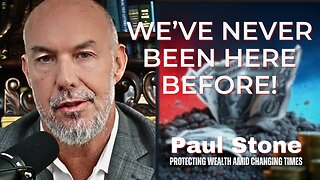Premium Only Content

Cuts From The Rolling Stones Number 2
The Rolling Stones No. 2 (1965)
"Everybody Needs Somebody to Love" Side 1 Track 1
"Under the Boardwalk" Side 2 Track 2
"You Can't Catch Me" Side 1 Track 3
"What a Shame" Side 1 Track 5
The Rolling Stones are a cover band. When Tavistock threw them together here was their second output.
The Rolling Stones No. 2 is the second studio album by the English rock band the Rolling Stones, released in 1965 following the success of their 1964 debut album The Rolling Stones. It contains three compositions from the still-developing Mick Jagger/Keith Richards songwriting team, with all the other songs being covers of American R&B and rock and roll numbers, similar to the first album.
On Dutch and German pressings of the album, the title is listed as The Rolling Stones Vol. 2 on the front cover, although the back of the album cover lists the title as The Rolling Stones No. 2.
Using the cover shot for 12 X 5, the second US-released album in October 1964, The Rolling Stones No. 2's track listing would largely be emulated on the upcoming US release of The Rolling Stones, Now!. While Eric Easton was co-credited as producer alongside Andrew Loog Oldham on the band's debut album, Oldham takes full production duties for this album, which was recorded sporadically in the UK and US during 1964.
A huge hit in the UK upon release, The Rolling Stones No. 2 spent 10 weeks at No. 1 in early 1965, becoming one of the year's biggest sellers in the UK. According to Bill Wyman in his book Stone Alone: The Story of a Rock 'n' Roll Band, John Lennon said of The Rolling Stones No. 2: "The album's great, but I don't like five-minute numbers."
Due to ABKCO's preference for the American albums, they overlooked both The Rolling Stones and The Rolling Stones No. 2 for CD release in 1986 and during its remastering series in 2002. Consequently, this album was out of print for many years and was thus widely bootlegged by collectors. It was again made available to the public as part of a limited edition vinyl box set, titled The Rolling Stones 1964–1969, in November 2010 and (by itself) digitally at the same time. The original title was also reinstated as part of The Rolling Stones in Mono box set, released on 30 September 2016.
"Everybody Needs Somebody to Love" is a song written by Bert Berns, Solomon Burke, and Jerry Wexler, and originally recorded by Burke under the production of Berns at Atlantic Records in 1964. Burke's version charted in 1964, but missed the US top 40, peaking at number 58.
The song is ranked number 429 on the Rolling Stone magazine's list of The 500 Greatest Songs of All Time.
On May 28, 1964, Burke recorded "Everybody Needs Somebody to Love" (Atlantic 2241), written by Burke (but also credited to Bert Berns and Jerry Wexler), which was Burke's most prominent bid for an enduring soul standard. Burke claims he was the sole writer on the song but was talked into sharing credit by Wexler and Berns.
In an interview Burke recalled the song's origins: "I used to do it in church when I was a kid and it was a march for the offering. We would play it with tubas, trombones and the big bass drum and it sounded really joyful. I played it to Jerry Wexler and Bert Berns, who thought that it was too fast, and had the wrong tempo."
In August 2008, Burke recalled that he had hired musicians from Charlotte, North Carolina, to play at a gig on Long Island and he drafted them in to play the instrumental riff on "Everybody Needs Somebody to Love". Burke described the recording: "Got the band cooking, get a bit of echo, we went through it, came back out, said to Jerry [Wexler], 'Whaddya think?' He said, 'Too fast. Doesn't have any meaning.' (Engineer) Tommy (Dowd) says, 'What can we lose? His band's here, let's just cut it.'" In this song, Burke employs the style of a black preacher, in "which he begins by delivering his message in a style of a sermon, and offering salvation".
Dave Marsh explains that in this song, "the porcine, gilt-fingered lay preacher testifies from the top but what you ought to hear is writ large between the lines, especially in the stentorian opening sermon. That is, when Burke sings "[There's a song I sing, and I believe] If everybody was to sing this song, it could save the whole world."
In 1997, Burke recalled: "When I did it for Jerry Wexler and Bert Burns (sic), they told me that song would never make it. I said, 'Well, I tell ya what—I'll give you a piece of it.' They said, 'That's the way we'll get the record played, so we'll take a piece of it.' In those days, they took a piece of your songs—a piece of the publishing—but in the end, you didn't have any pieces left. Even now, I'm still struggling to get the publishing, the royalties, and that'll never happen."
Jerry Wexler maintained in 2002: "I know Solomon is upset about that, and I wrote him a long letter explaining how we wrote the song together and that he has always gotten his share of the royalties. I know that because I get royalty checks for the song. The whole process of making a record is a collaborative affair and the issue of who does just what on a song sometimes gets confusing, but not on that song. We wrote it in Bert's apartment. Bert had a guitar and we wrote it together."
"Under the Boardwalk" is a pop song written by Kenny Young and Arthur Resnick and recorded by the Drifters in 1964. It charted at number four on the Billboard Hot 100 chart on August 22, 1964. The song has since been covered by many other artists, with versions by Bette Midler, Sam & Dave, Tom Tom Club, The Rolling Stones, Billy Joe Royal, The Beach Boys, Bruce Willis, Bad Boys Blue, John Mellencamp and Lynn Anderson all charting in the United States or overseas. The song ranked number 487 on Rolling Stone's list of The 500 Greatest Songs of All Time in 2004 and number 489 in 2010.
The song was set to be recorded on May 21, 1964, but the band's lead singer, Rudy Lewis, died of a suspected heroin overdose the night before. Lewis had sung lead on most of their hits since the 1960 departure of Ben E. King, including "Up on the Roof". Rather than reschedule the studio session, the lead on "Under the Boardwalk" was given to the group's other lead vocalist, Johnny Moore, who had returned to the group in April 1963. The personnel on that recording included Ernie Hayes on piano, Everett Barksdale, Bill Suyker and Bob Bushnell on guitar, Milt Hinton on bass, Gary Chester on drums and George Devens on percussion. The arranger was Teacho Wiltshire. The last-minute move was a success, as the single, released on Atlantic Records, went to number four on the Billboard Hot 100 charts and number one for three non-consecutive weeks on Cashbox magazine's R&B chart.
In 2014, this recording of the song was inducted into the Grammy Hall of Fame.
A cover of this song by the Rolling Stones was released the same year as the original version. Their version was released as a single only in Australia, South Africa and Rhodesia, and peaked at No. 1 in the first two (the song was the band's first No. 1 hit in Australia) and at No. 2 in Rhodesia. It appeared on their albums 12 X 5 and The Rolling Stones No. 2.
"You Can't Catch Me" is a song written for 1956 musical drama film Rock, Rock, Rock!. It was recorded by Chuck Berry and released as a single in 1956.
The song's lyrics describe racing a souped-up "air-mobile" down the New Jersey Turnpike, then unfolding its wings and taking off. At the time, the Aerocar designed and built by Molt Taylor was nearing Civil Aviation Authority approval for mass production as a flying car with detachable folding wings.
Berry's song was featured in the 1956 film Rock, Rock, Rock and was one of the four songs from the film that was included on the "soundtrack" album (the only one of his songs to be used both in the movie and on the album).
Originally recorded by Berry in May 1955 at Universal Recording Corp. for Chess Records during the same session as "Maybellene" and "Wee Wee Hours", the lyrics refer to both of those songs.
Cover versions of the song were also recorded by Sleepy LaBeef for a 1963 single, by The Rolling Stones for their 1965 album The Rolling Stones No. 2, and by The Blues Project for their 1966 album Projections. It was also done by Love Sculpture for their 1970 album Forms and Feelings, George Thorogood and the Destroyers for their 1988 album Born to Be Bad, Jo Jo Zep & The Falcons on their 2003 album Ricochet and by Florence Rawlings for her 2009 debut album A Fool in Love.
What a Shame is three minutes and three seconds... now enjoy!!!
The Rolling Stones
Mick Jagger – lead vocals, harmonica, tambourine
Keith Richards – electric guitar, backing vocals, acoustic guitar
Brian Jones – electric guitar, percussion
Bill Wyman – bass guitar, backing vocals
Charlie Watts – drums
-
 15:58
15:58
Psychological operations
7 days agoPrince Rick James Super Freak 1999
664 -
 1:45:47
1:45:47
The Quartering
6 hours agoHuge Censorship Law To Pass, Trump Endorses Johnson, TikTok is Saved? & Today's News!
71K59 -
 53:39
53:39
PMG
3 days ago $0.35 earned"Allegations Against Diddy & Usher, $150K Bounty on Trump, RINO Speaker Caves w/Steve Baker"
1.01K -
 1:31:21
1:31:21
Tucker Carlson
5 hours agoBrigham Buhler: UnitedHealthcare CEO Assassination, & the Mass Monetization of Chronic Illness
158K200 -
 2:29:04
2:29:04
Nerdrotic
5 hours ago $9.80 earnedHappy New Years - Nerdrotic Nooner 454
62.3K11 -
 32:20
32:20
Rethinking the Dollar
5 hours agoThe U.S. Debt Crisis That Was "Made In America" w/ Paul Stone
44.1K10 -
 3:31
3:31
SLS - Street League Skateboarding
1 day agoCoco Yoshizawa’s 3rd Place Finish at SLS Tokyo 2024 | Best Tricks
50.4K5 -
 46:15
46:15
Grant Stinchfield
1 day ago $12.15 earnedNew: The COVID Cover-up Revealed! Team Biden Caught in a Big Lie!
46.6K18 -
 2:35:08
2:35:08
The Shannon Joy Show
19 hours ago🔥🔥LIVE Exclusive W/Daniel Horowitz - New Year 2025 Analysis On Culture, Economy & Politics🔥🔥
54.2K17 -
 33:14
33:14
Tudor Dixon
5 hours agoThe World Walk with Tom Turcich | The Tudor Dixon Podcast
36.5K2